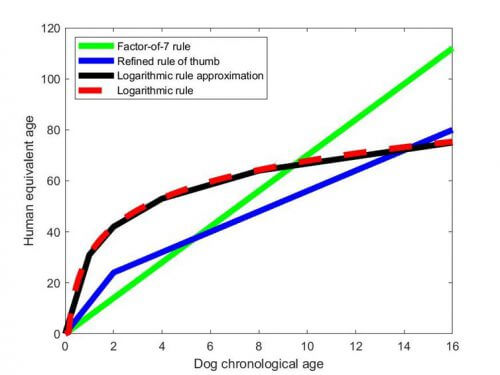The basic premise is that each calendar year a dog lives is equivalent to seven human years at each stage of a dog's life. But a new study shows that things are not so simple
By Christian Yates, Senior Lecturer in Biological Mathematics, University of Bath, UK. Translated by Nahum Sherashevsky

If your dog has been alive and kicking his paws for about a decade, the popular opinion is that he has aged like a human would at the respectable age of 70. This conversion factor - each year of a dog's life is considered seven human years - is obtained by dividing the human life expectancy - environments by 77 - in the canine life expectancy - environments 11.
The basic premise is that each calendar year a dog lives is equivalent to seven human years at each stage of a dog's life. But a new study shows that things are not so simple. And if we examine some basic developmental landmarks, it's clear why.
For example, most dog breeds reach sexual maturity between the ages of six and 12 months - the upper limit of this range corresponds, according to the traditional conversion, to the human age of seven. And at the other end of the spectrum, although it's not common, there are dogs that are known to have lived more than 20 years. According to the "factor of seven" conversion rule, this would be equivalent to the eternal age of 140 human years.
And to complicate matters further, the life expectancy of dogs depends significantly on the breed. Smaller dogs tend to live significantly longer, and what's more, they age more slowly than larger dogs.
All this raises the question of what exactly we mean when we say age. The most obvious way to describe it is simply the amount of time that has passed since birth. This is known as the chronological definition of age.
But there are also other descriptions. "Biological age", for example, is a more subjective definition, which depends on the assessment of physiological indicators to identify a person's development. This includes indices such as the "exhaustion index" - surveys that take into account the person's disease state, cognitive impairment and activity levels.
And there are more objective biological markers for aging, such as gene expression levels (genes produce proteins at different rates in different life stages) or the number of immune cells. The rate at which biological age increases depends on genetic hereditary factors, mental health and lifestyle.
For example, if you spent a lot of time eating junk food and smoking cigarettes instead of exercising and eating healthy, chances are your biological age will exceed your chronological age. Or maybe you are 60 years old with a 40 year old body if you have taken good care of yourself.
A new look at a dog's life
When it comes to comparing the age of animals of different species, the biological definitions of age are much more useful than the chronological equivalents. Knowing that a hamster is six weeks old does not give good information about the life stage of that animal even if you know that a hamster's lifespan is only three years. Knowing that a hamster has reached an age where it can breed is much better information about its maturity level.
The authors of the new study on aging say that a logical way to measure biological age is through so-called "epigenetic clocks" - changes in the packaging of our DNA that accumulate over time in all mammals.
In particular, "methylation"—the addition of methyl groups (a carbon atom bonded to three hydrogen atoms) to DNA—seems to be a good indicator of age. Many prominent physiological markers, such as the development of teeth, appear to show the same levels of methylation in different species. So by matching methylation levels in Labradors and humans, the researchers derived a formula for mapping the dog's age to its human equivalent.
The formula is: equivalent human age = 16 times (the chronological age of the dog)ln plus 31.
human equivalent age = 16 x ln(dog's chronological age) + 31.
ln in the formula represents a mathematical function called the natural logarithm. The logarithmic function is very well known in the non-linear scale of the energy released in an earthquake (Richter scale) or in the measurement of sound (decibels). It is useful in measuring quantities whose size varies over many orders of magnitude. It is even possible, as I explore in my new book The Mathematics of Life and Death, that a logarithmic experience of the passing of time may explain why we feel that time passes more quickly as we age.
In the graph below, you can see the operation of the natural logarithm in the conversion of the years a dog has lived (the age of the dog) to the equivalent human age in the dotted red curve. The curve shows that dogs reach maturity very quickly at first, but then their aging slows down, meaning that they experience most of their lives as a kind of continuous middle age.

A useful shortcut is to remember that a dog's first year counts as 31 human years. Then every time the dog's chronological age is doubled, the number of equivalent human years increases by 11. So eight calendar years are three "multiplications" (from one to two, from two to four and then from four to eight) and the age of a dog is obtained which is equivalent to 64 (31 + 3×11).
This useful approximation is plotted as the black curve in the conversion figure below. The green line represents the factor of seven rule whose reliability has been undermined and unrealistic ages at the upper end of the dogs' age range emerge from it.
To the article on THE CONVERSATION website
More of the topic in Hayadan:

30 תגובות
I think it's just a joke we say that the chelas lived longer just so we won't be sad that he died very early
Aren't you tired of lying or deceiving people, you nitpickers, an article that is not worth my brown, used toilet paper
According to my formula
A dog's age corresponds to a human's age. A dog's age corresponds to a human's age
1 20 6 60
2 25 7 60
3 30 8 60
4 45 9 65
5 55 10 70
11 75
12 80
13 82
Here the dog is supposed to die like an average human. Everything else is a bonus. 16 is equivalent to 90.
Note that you have to add 11 when the age is *doubled*. Not every year. (meaning the dog is 2 years old, then 4, then 8 in his actual years). In each such jump, the H.S.F. has 11. (and there are other elements in the formula).
Although you are right that the formula is not the simplest. If the dog is 6 and a half years old, it is not easy to calculate in your head what his real age is.
—
For the news - "Alex Ander" is responding to the payment of the new fund.
They flood Israeli websites with comments funded by foreign governments.
My dog is 11 years old.
If I understood the formula correctly, 11*16 +31 = 270.
I mean my dog is 270 years old?
Hb
It seems that the record of vanity has been broken in one article. Let's start by saying that the 7th scale is an archaic concept that for many years has not been used to compare the age of a dog to the age of a human being. It seems that the celebrated researcher relied more on gut feelings, prejudices and a superficial acquaintance with canine biology than on scientific research. It's a shame that the science magazine doesn't bother to invest a little more in filtering the articles it chooses to translate and upload.
An incomprehensible and unrealistic formula
How many slaps can be found in one article
Let's say that after a year he is 31 years old
They wrote there that within a year he was already sexually mature
As far as I remember, humans can have children before the age of 18
Joke scientists
It can be an opening to understand many other things...
So it's not unnecessary research at all.
According to one of the explanations presented in the article. Multiply the dog's age by 11 and add 31. According to this calculation, my 11-year-old is equivalent to a 152-year-old person. Interesting. He runs like a 45 year old even though I brought him a walker and a Filipino therapist.
According to the responses here, it can be concluded that we live in a country whose ability to understand and draw conclusions is beyond criticism.
And others ask and wonder why Bibi has been in the spotlight for over a decade.
On the other hand, if the people are so stupid, it might be useful to simplify the form of the articles, not to include too much research information and complicated formulas. Just give an easy explanation and a graph.
On the other hand, they read with knowledge, they should have a mind.
dilemma
It started nice and understandable...but later on
Everything got complicated and messed up... and I didn't understand anything.
My God, you want to tell me that the journalist Sylvie Keshet is already 630 years old and you still don't see the end of her.
What is to be understood
An accurate explanation with a simple formula that relates to every part of a dog's life
The human age is multiplied by 3 and peace be upon Israel. Lani is a mess.
Why not write simply and clearly..what is all this head confusion.
Hello everyone,
In my opinion, the article is written in a clear and simple way to understand.
In order to calculate the dog's age, you need a little scientific background.
The formula is:
31 + (the age of the dog) 16xln = the age of the dog to the human equivalent
Let's say the age of the dog is 12 years, and you want to know the equivalent human age.
Open the calculator in its scientific configuration on the computer,
For those who don't know, on the calculator on the top left side there are three lines, click and you get a list,
Choose SCIENTIFIC.
Write the dog's age in the calculator, and then press ln (it will be found on the lower left side of the calculator)
Multiply by 16 and add 31.
The dog age in human equivalent is 70 years
Dear puppy, a dog's age is not calculated in human years. Large breed dogs live less. Small pinschers can annoy up to the age of 30. We also shorten their lives with nonsense like mutilating or using the dog as a breeding machine (not long ago a 6-year-old (very young) purebred Shih Tzu came to SOS Animals, who was quartered all his life, but was Toothless because it was not treated.
Woof woof
Either it was written brilliantly or I'm a misunderstanding, I haven't understood the literal meaning yet
I really haven't read such nonsense in a long time. Who are the delusional people who conducted the "research"?
How many dog years is equal to a human year... what does it matter? Why is this relevant?
I was completely confused.
What the hell??? Is it possible that the most unclear??
A confused, stupid article that lacks all expression and explanation.
A dog is a dog, confuses me
what?
I didn't understand anything, why complicate life over nonsense
Ln10 is not ten
I did not understand anything
A 10-year-old dog multiplied by 16 is 160 and add 31? = 191?